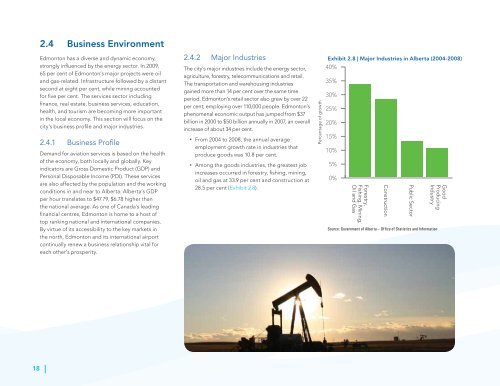Edmonton International Airport - EIA Corporate
Edmonton International Airport - EIA Corporate
Edmonton International Airport - EIA Corporate
You also want an ePaper? Increase the reach of your titles
YUMPU automatically turns print PDFs into web optimized ePapers that Google loves.
2.4 Business Environment<br />
<strong>Edmonton</strong> has a diverse and dynamic economy,<br />
strongly influenced by the energy sector. In 2009,<br />
65 per cent of <strong>Edmonton</strong>’s major projects were oil<br />
and gas-related. Infrastructure followed by a distant<br />
second at eight per cent, while mining accounted<br />
for five per cent. The services sector including<br />
finance, real estate, business services, education,<br />
health, and tourism are becoming more important<br />
in the local economy. This section will focus on the<br />
city’s business profile and major industries.<br />
2.4.1 Business Profile<br />
Demand for aviation services is based on the health<br />
of the economy, both locally and globally. Key<br />
indicators are Gross Domestic Product (GDP) and<br />
Personal Disposable Income (PDI). These services<br />
are also affected by the population and the working<br />
conditions in and near to Alberta. Alberta’s GDP<br />
per hour translates to $47.79, $6.78 higher than<br />
the national average. As one of Canada’s leading<br />
financial centres, <strong>Edmonton</strong> is home to a host of<br />
top ranking national and international companies.<br />
By virtue of its accessibility to the key markets in<br />
the north, <strong>Edmonton</strong> and its international airport<br />
continually renew a business relationship vital for<br />
each other’s prosperity.<br />
2.4.2 Major Industries<br />
The city’s major industries include the energy sector,<br />
agriculture, forestry, telecommunications and retail.<br />
The transportation and warehousing industries<br />
gained more than 14 per cent over the same time<br />
period. <strong>Edmonton</strong>’s retail sector also grew by over 22<br />
per cent; employing over 110,000 people. <strong>Edmonton</strong>’s<br />
phenomenal economic output has jumped from $37<br />
billion in 2000 to $50 billion annually in 2007, an overall<br />
increase of about 34 per cent.<br />
• y From 2004 to 2008, the annual average<br />
employment growth rate in industries that<br />
produce goods was 10.8 per cent.<br />
• y Among the goods industries, the greatest job<br />
increases occurred in forestry, fishing, mining,<br />
oil and gas at 33.9 per cent and construction at<br />
28.5 per cent (Exhibit 2.8).<br />
Percentage of growth<br />
Exhibit 2.8 | Major Industries in Alberta (2004-2008)<br />
40%<br />
35%<br />
30%<br />
25%<br />
20%<br />
15%<br />
10%<br />
5%<br />
0%<br />
Forestry,<br />
Fishing, Mining,<br />
Oil and Gas<br />
Construction<br />
Public Sector<br />
Source: Government of Alberta – Office of Statistics and Information<br />
Good<br />
Producing<br />
Industry<br />
18




